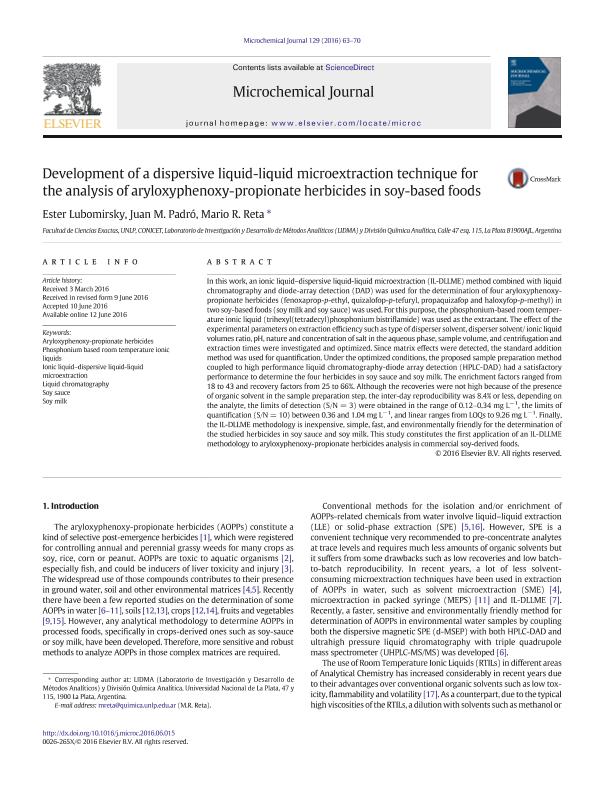Mostrar el registro sencillo del ítem
dc.contributor.author
Lubomirsky, Ester

dc.contributor.author
Padró, Juan Manuel

dc.contributor.author
Reta, Mario Roberto

dc.date.available
2018-08-08T15:32:09Z
dc.date.issued
2016-06
dc.identifier.citation
Lubomirsky, Ester; Padró, Juan Manuel; Reta, Mario Roberto; Development of a dispersive liquid-liquid microextraction technique for the analysis of aryloxyphenoxy-propionate herbicides in soy-based foods; Elsevier Science; Microchemical Journal; 129; 6-2016; 63-70
dc.identifier.issn
0026-265X
dc.identifier.uri
http://hdl.handle.net/11336/54561
dc.description.abstract
In this work, an ionic liquid–dispersive liquid-liquid microextraction (IL-DLLME) method combined with liquid chromatography and diode-array detection (DAD) was used for the determination of four aryloxyphenoxy-propionate herbicides (fenoxaprop-p-ethyl, quizalofop-p-tefuryl, propaquizafop and haloxyfop-p-methyl) in two soy-based foods (soy milk and soy sauce) was used. For this purpose, the phosphonium-based room temperature ionic liquid (trihexyl(tetradecyl)phosphonium bistriflamide) was used as the extractant. The effect of the experimental parameters on extraction efficiency such as type of disperser solvent, disperser solvent/ ionic liquid volumes ratio, pH, nature and concentration of salt in the aqueous phase, sample volume, and centrifugation and extraction times were investigated and optimized. Since matrix effects were detected, the standard addition method was used for quantification. Under the optimized conditions, the proposed sample preparation method coupled to high performance liquid chromatography-diode array detection (HPLC-DAD) had a satisfactory performance to determine the four herbicides in soy sauce and soy milk. The enrichment factors ranged from 18 to 43 and recovery factors from 25 to 66%. Although the recoveries were not high because of the presence of organic solvent in the sample preparation step, the inter-day reproducibility was 8.4% or less, depending on the analyte, the limits of detection (S/N = 3) were obtained in the range of 0.12–0.34 mg L− 1, the limits of quantification (S/N = 10) between 0.36 and 1.04 mg L− 1, and linear ranges from LOQs to 9.26 mg L− 1. Finally, the IL-DLLME methodology is inexpensive, simple, fast, and environmentally friendly for the determination of the studied herbicides in soy sauce and soy milk. This study constitutes the first application of an IL-DLLME methodology to aryloxyphenoxy-propionate herbicides analysis in commercial soy-derived foods.
dc.format
application/pdf
dc.language.iso
eng
dc.publisher
Elsevier Science

dc.rights
info:eu-repo/semantics/openAccess
dc.rights.uri
https://creativecommons.org/licenses/by-nc-sa/2.5/ar/
dc.subject
Aryloxyphenoxy-Propionate Herbicides
dc.subject
Ionic Liquid&Ndash;Dispersive Liquid-Liquid Microextraction
dc.subject
Liquid Chromatography
dc.subject
Phosphonium Based Room Temperature Ionic Liquids
dc.subject
Soy Milk
dc.subject
Soy Sauce
dc.subject.classification
Otras Ciencias Químicas

dc.subject.classification
Ciencias Químicas

dc.subject.classification
CIENCIAS NATURALES Y EXACTAS

dc.title
Development of a dispersive liquid-liquid microextraction technique for the analysis of aryloxyphenoxy-propionate herbicides in soy-based foods
dc.type
info:eu-repo/semantics/article
dc.type
info:ar-repo/semantics/artículo
dc.type
info:eu-repo/semantics/publishedVersion
dc.date.updated
2018-08-08T15:01:37Z
dc.journal.volume
129
dc.journal.pagination
63-70
dc.journal.pais
Países Bajos

dc.journal.ciudad
Amsterdam
dc.description.fil
Fil: Lubomirsky, Ester. Consejo Nacional de Investigaciones Científicas y Técnicas; Argentina. Universidad Nacional de La Plata. Facultad de Ciencias Exactas; Argentina
dc.description.fil
Fil: Padró, Juan Manuel. Consejo Nacional de Investigaciones Científicas y Técnicas; Argentina. Universidad Nacional de La Plata. Facultad de Ciencias Exactas; Argentina
dc.description.fil
Fil: Reta, Mario Roberto. Consejo Nacional de Investigaciones Científicas y Técnicas; Argentina. Universidad Nacional de La Plata. Facultad de Ciencias Exactas; Argentina
dc.journal.title
Microchemical Journal

dc.relation.alternativeid
info:eu-repo/semantics/altIdentifier/doi/https://dx.doi.org/10.1016/j.microc.2016.06.015
dc.relation.alternativeid
info:eu-repo/semantics/altIdentifier/url/https://www.sciencedirect.com/science/article/pii/S0026265X16300960
Archivos asociados
